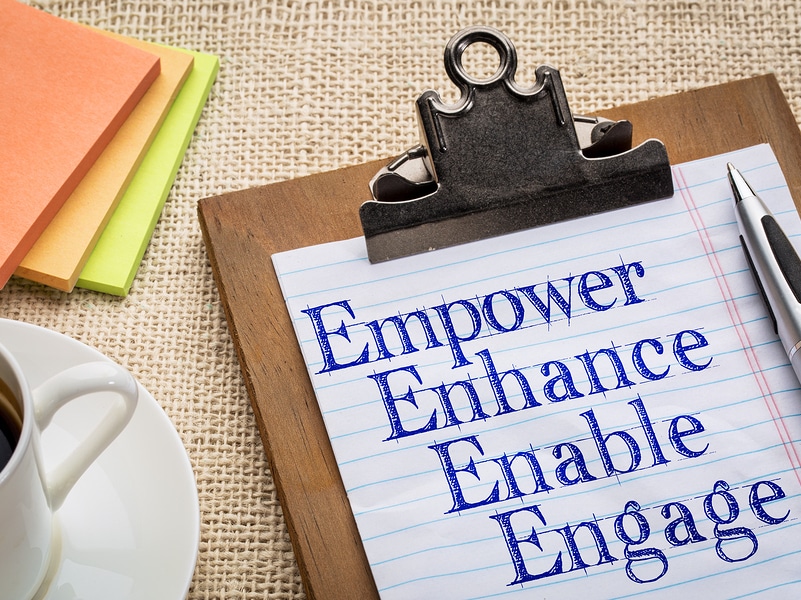Employee Engagement Activities: 3 Critical Steps

For successful employee engagement activities, do these 3 things first:
1. Map the employee journey
2. Conduct ‘stay’ interviews
3. Automate HR
When you’ve completed these steps, you will know how to structure your engagement programs.
1. Map The Employee Journey Before Creating Employee Engagement Activities
The starting point is the employee journey. The employee journey is everything that happens from the moment a job candidate applies to their last day of work. (If you offer retirement benefits, the journey continues…)
How does the employee journey differ from the employee life cycle? The employee journey is experienced from the employee’s perspective. The employee life cycle is the process from an administrative, or employer, perspective.
A thousand little things combine to create a positive or a negative journey. Or—as is probably the case—something in between.
Your Employee Journey Creates Emotions
The employee journey is subjective. It creates an emotion. When employees experience a positive emotion connected to their work, they stay with your company. Positive emotions create engagement.
Employees who have a positive attitude invest in your purpose. And they do all they can to help the company succeed.
By mapping the employee journey, you can determine where your company falls on the spectrum. Of course, the journey isn’t the same for every employee. The employee’s manager, department, and team influence it.
Improving the employee journey is the first priority when it comes to employee engagement activities.
How Do You Map The Employee Journey?
Your marketing team knows how to map the customer journey. The same principles apply here.
Create an employee persona for each job position or department. Leave age, gender, ethnicity out of the persona. They aren’t important for this exercise.
When you’ve created your employee personas, create a roadmap of interactions. Using a timeline template can make this easier.
Document each touchpoint. Start before they are hired. For example, how easy is it to apply on your website careers page? How was the job interview?
When the employee accepts the job offer, the journey continues.
Do You Create an Outstanding First Day?
The first day of work is full of key touchpoints. Suppose the new hire receives an email the day before they start. The email explains where to park and how to get past security.
When they show up, their manager and a couple team members greet them. They know the new hire’s name.
The welcome team takes them around to meet the rest of the department.
Their work station has everything ready to go. IT has given them their login credentials.
Is Onboarding Structured And Hassle-Free?
The onboarding process contains additional interactions. How does the employee choose their health insurance plan? Are they handed a stack of forms? Are they directed to read an outdated paper handbook? How do they get set up for payroll?
Onboarding and training are crucial. Interactions with their manager are crucial.
Once the employee has been onboarded and assimilated, they interact with HR through payroll, PTO, and benefits management.
When you’ve documented the journey for each employee persona, it’s time to see how it’s working for your team members.
2. Conduct ‘Stay’ Interviews Before Creating Employee Engagement Activities
‘Stay’ interviews will help you find the weak points. Interview each of your employees. This is best done by someone in HR. You want employees to be candid about their relationship with their manager.
Here are some important questions to ask:
- Did onboarding work like it’s supposed to?
- Do you have enough training to perform your job?
- Is payroll a smooth process?
- Is it a hassle to use your health benefits?
- Do you understand how to access HR information?
- Does your manager recognize your efforts?
- Are you aware of advancement opportunities?
- Do you understand how your work contributes to the bottom line?
- Where do you see yourself in 3 years?
- How can we improve?
3. Automate HR to Remove Obstacles to Engagement
Companies who automate HR improve engagement. Without fail. Every employee performs administrative transactions continually. They punch in, turn in timecards, and receive a paycheck. Workers request shift trades and vacation time. Plus they enroll in a health plan and use their benefits.
An integrated HR system streamlines these processes. It provides transparency for employees, managers, and HR. It allows employees to perform transactions themselves. Self-service is particularly important to millennials and generations following on their heels.
Self-Service and Mobility
Unified HR portals have companion mobile apps. Self-service and mobility are vital for engagement.
Here are some the tools in a unified HR interface:
- Onboarding
- Electronic signatures, health plan enrollment, training
- Payroll
- Pay stubs, W2, direct deposit, 1099/1095 forms, quarterly reports, paycheck notifications
- Document Library
- Employee handbook, procedures, company resources
- Employee Engagement
- Company directory, rewards programs, suggestion box
- Time & Attendance
- Timecards, punch in/out, schedule, shift trades, vacation requests, monitor PTO accruals
Employee Engagement Activities
When you’ve completed the 3 steps discussed, you will be ready to choose engagement activities wisely.
You’ll know the weak links in the employee journey. You’ve streamlined HR to remove obstacles to engagement. During the stay interviews, you gathered feedback.
Why Should Every Employer Pay Attention to Employee Engagement Activities?
Employers must deal with the following critical facts:
- Millennials make up the largest workforce demographic.
- Millennial turnover costs the U.S. economy $30.5 billion annually. (Source: Gallup)
When your workforce consists of untethered job-hoppers, you can’t take engagement for granted.
Employee engagement activities are no longer optional. You can’t hire and retain millennials unless you engage them.
We wish you luck with your engagement activities.
Simplify HR management today.
Simplify HR management today.
Navigating the Complexities of Healthcare Recruitment
The healthcare sector is renowned for its rewarding nature, offering professionals the chance to significantly impact individuals’ lives by aiding in their recovery from various ailments and conditions. However, for those tasked with recruitment within this sector, the challenges are plentiful. Delve into our in-depth guide for an array of strategies to elevate your healthcare…
Read MoreHow Improving Candidate Engagement Influences the Hiring Process
Applicants invest considerable time, effort, and thought into their job applications. Regrettably, it’s all too common for employers to delay responses, with some failing to provide any follow-up whatsoever. Such practices can have a negative effect on the candidate experience, influencing your organization’s hiring efficiency and reputation. Ensuring a positive experience for candidates is crucial…
Read More





